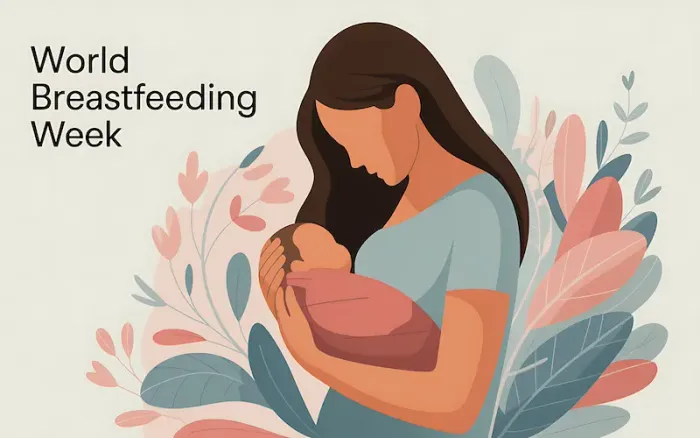World Breastfeeding Week: A Practical Guide
Discover a step-by-step guide for World Breastfeeding Week 2024. Learn benefits for baby, mother, and society, tackle common challenges, plan workplace routines, and take part in community initiatives.

Written by Dr. Siri Nallapu
Reviewed by Dr. Dhankecha Mayank Dineshbhai MBBS
Last updated on 28th Oct, 2025

Introduction
Every year from 1–7 August, millions of families, health workers, and advocates come together for World Breastfeeding Week. More than a celebration, this global week highlights practical ways to protect, promote, and support breastfeeding—at home, in hospitals, at work, and in our communities. Whether you are an expectant parent, a new mother, a caregiver, or a workplace leader, this guide turns World Breastfeeding Week into a clear, action-ready plan.
In the pages that follow, you’ll learn why breastfeeding matters for babies, mothers, and society; how to start strong in the first hours and weeks; practical solutions to common challenges; and what workplaces and communities can do to make breastfeeding possible for all. We’ll also show how to participate in World Breastfeeding Week with simple, high-impact steps you can take today, plus tools, checklists, and visual ideas to share. Along the way, we draw on leading guidance from WABA, WHO, UNICEF, the CDC, and the AAP—so you can count on evidence-based advice. Let’s make this World Breastfeeding Week the moment your support—and your voice—makes a lasting difference.
What World Breastfeeding Week Is—and Why It Matters
Here's what you need to know about the week:
Dates, Themes, and Global Partners
World Breastfeeding Week (WBW) runs every year from 1–7 August, led by the World Alliance for Breastfeeding Action (WABA) with support from WHO and UNICEF. Recent themes focus on system-level support and equity, such as enabling breastfeeding for working parents (2023) and closing gaps in access to support (2024). This annual rhythm keeps attention on the policies and everyday practices that help families start and continue breastfeeding.
What WBW Aims to Change
WBW brings together families, health systems, workplaces, and communities to achieve three essentials: informed choice, skilled support, and enabling environments. It promotes early initiation within one hour of birth, exclusive breastfeeding for the first six months, and continued breastfeeding up to two years and beyond, alongside complementary foods.
Why a Week Works
Campaign weeks focus momentum, but the real power is in what happens before and after: preparing for birth, choosing Baby-Friendly hospitals, securing workplace accommodations, and linking families to local support groups. WBW acts as a yearly “reset”—a time to set goals, refresh policies, and share progress publicly.: Consult Top Specialists
Benefits of Breastfeeding for Baby, Mother, and Society
Here's why breastfeeding matters:
For Babies: Protection and Development
Breastmilk provides ideal nutrition and immune protection. It reduces gastrointestinal and respiratory infections and lowers the risk of sudden infant death syndrome (SIDS). Colostrum—the first milk—primes the newborn gut and immunity.
For Mothers: Health Now and Later
Breastfeeding is associated with lower risk of breast and ovarian cancers, type 2 diabetes, and hypertension. It supports postpartum recovery and may help with birth spacing when using the Lactational Amenorrhea Method under strict criteria.
For Society: Equity and Economics
Breastfeeding reduces healthcare costs and environmental impact. Improved breastfeeding rates can bring economic benefits through reduced disease burden and better cognitive outcomes. Health systems that implement Baby-Friendly practices see higher early initiation and exclusive breastfeeding rates.
Starting Strong: The First Hours and Weeks
Here's how to set up for success:
Skin-to-Skin and the First Hour
Early initiation matters. Placing your baby skin-to-skin within an hour of birth stabilises temperature, heart rate, and breathing, and increases the chance of exclusive breastfeeding. Ask your birth facility about uninterrupted skin-to-skin—especially after C-section—to support latch and early milk transfer.
Latch and Positioning Basics
A deep latch is the foundation. Cues you’re on track include a wide-open mouth, more areola visible above than below, chin touching breast, and steady swallowing. Comfortable positions include laid-back, cradle, cross-cradle, and side-lying. Ask for hands-on help from a nurse, midwife, or lactation consultant.
Signs Baby Is Getting Enough Milk
In the first week, diapers indicate intake. Expect at least six wet diapers and three or more yellow, seedy stools daily after day five, steady weight gain, and regular audible swallows. Track diapers for the first two weeks and weigh baby at scheduled visits to confirm adequate intake.
Overcoming Common Challenges—With When to Seek Help
Here's guidance on common issues:
Nipple Pain and Latch Issues
Pain beyond initial latch often signals a shallow latch or positioning problem. Try repositioning, breaking suction gently with a finger to relatch, and starting on the less tender side. If pain persists or nipples crack or bleed, seek skilled help.
Low Supply: Assess and Act
Many perceive “low supply,” but often it is normal cluster feeding. True low supply can arise from infrequent feeding, ineffective latch, retained placenta, thyroid issues, or certain medications. Interventions include increasing frequency, ensuring a deep latch, offering both breasts, and hand expression after feeds. If medical causes are suspected, speak with a clinician.
Mastitis, Plugged Ducts, and Red Flags
Symptoms include a tender wedge on the breast, redness, fever, and flu-like feelings. Continue feeding to drain the breast, rest, hydrate, and use cold packs. If symptoms persist beyond 24–48 hours or fever develops, consult a doctor online with Apollo 24|7 for evaluation and possible antibiotics.
Special Situations: C-section, Preterm, and Donor Milk
After C-section, ask for modified positions and extra support for skin-to-skin. For late preterm or sleepy babies, paced feeding, breast compressions, and expressed milk may be needed. Where medically indicated, screened donor human milk from accredited milk banks can be lifesaving.: Consult Top Specialists
Breastfeeding and Work: Rights, Pumping, and Practical Routines
Here's how workplaces can support:
Your Rights and Policies That Help
Supportive laws and workplace policies double the odds of exclusive breastfeeding at six months. Effective measures include paid parental leave, flexible schedules, lactation breaks, and clean, private pumping spaces. If your workplace lacks policy, use WBW to propose one
Pumping and Breast Milk Storage Guidelines
Build a routine 2–3 weeks before returning to work: add one pumping session daily to create a small freezer stash. Fresh milk is safe at room temperature up to 4 hours, in the refrigerator up to 4 days, and in the freezer ideally up to 6 months (acceptable up to 12 months). Thawed milk should be used within 24 hours if refrigerated; never refreeze.
Case Example: A Small Office That Made It Work
A small startup designated a multi-use room as a lactation space, added a privacy lock, mini-fridge, and calendar for scheduling. They integrated 2–3 short pumping breaks into workflows, leading to no productivity loss, better retention, and a model policy shared each WBW.
Community Action for World Breastfeeding Week
Here's how communities can engage:
Families: Simple Ways to Participate
Share stories on social media with the WBW hashtag, join local walks or latch-on events, or thank maternity nurses. Build a personal action plan: choose a Baby-Friendly birth facility, line up postpartum support, and prepare your home feeding station.
Health Systems and Baby-Friendly Practices
Hospitals implementing the Ten Steps to Successful Breastfeeding—immediate skin-to-skin, rooming-in, no unnecessary supplementation, and skilled lactation support—improve breastfeeding initiation and exclusivity. Facilities can audit practices during WBW, train staff, and publicly share progress.
Social Media, Schools, and Civic Spaces
Use WABA’s social media toolkit to share accurate messages. Schools and community centres can host Q&A sessions with midwives or paediatricians. Libraries can create WBW book displays, and local governments can declare WBW proclamations to normalise breastfeeding across generations.
Nutrition, Mental Health, and Inclusive Support
Here's how to support wellbeing:
Eating Well and Staying Hydrated
Aim for balanced meals with whole grains, proteins, fruits, vegetables, and healthy fats. Hydrate to thirst. Postpartum anaemia and thyroid issues can affect energy and milk production; Apollo 24|7 offers convenient home collection for tests like haemoglobin or thyroid screening.
Emotional Wellbeing and Partner Support
Feeding a newborn can be intense. Watch for signs of postpartum mood disorders. Partners can help with burping, diaper changes, and meals. If symptoms persist beyond two weeks, consult a doctor online with Apollo 24|7.
Inclusive Practices for Every Family
Breastfeeding and chestfeeding support should include adoptive parents (induced lactation), LGBTQ+ families, parents with disabilities, and families using combination feeding or donor milk. The International Code of Marketing of Breast-milk Substitutes helps families make informed, pressure-free decisions.
Myths vs Facts You’ll Hear During World Breastfeeding Week
Here's the truth behind common myths:
• “Small breasts mean low supply.” Fact: Supply depends on demand and effective milk removal, not breast size.
• “You must space feeds strictly.” Fact: On-demand feeding supports supply and baby’s growth.
• “Formula after birth helps babies sleep.” Fact: Non-medically indicated supplementation can disrupt early supply and alter the newborn gut.
• “You can’t breastfeed after returning to work.” Fact: With pumping breaks, private space, and storage, many families continue successfully.
Conclusion
World Breastfeeding Week is a yearly chance to align knowledge, support, and systems so that breastfeeding becomes possible, not just ideal. By focusing on the first hours and weeks, championing Baby-Friendly practices, and securing workplace routines, families can navigate common hurdles with confidence. The science is clear: breastfeeding protects babies, supports mothers’ long-term health, and pays dividends for society. Equally important are skilled support, inclusive policies, and communities that normalise and celebrate feeding choices free of commercial pressure.
As WBW approaches, pick one action you can take: confirm your hospital’s breastfeeding support, schedule a lactation consult, propose a workplace lactation room, or share accurate information with your network. If you encounter pain, low supply, or symptoms like fever, seek timely care—consult a doctor online with Apollo 24|7 or book a visit if needed. Whether exclusively breastfeeding, combination feeding, or using donor milk, evidence-based care and respect are key. Make this World Breastfeeding Week the start of a practical plan that honours your family’s needs and helps your community grow healthier together.: Consult Top Specialists
: Consult Top Specialists

Dr. Abhishek Daga
Obstetrician and Gynaecologist
20 Years • MBBS, MS (Obstetrics & Gynaecology)
Kolkata
Gynae Care Fertility Centre, Kolkata
(150+ Patients)

Dr. Vidya Konduri
Obstetrician and Gynaecologist
9 Years • MS
Chinagadila
Apollo Hospitals Health City Unit, Chinagadila
(50+ Patients)

Dr. Asawari Kesari Kapoor
Obstetrician and Gynaecologist
23 Years • M.B.B.S, D.G.O(Mumbai) ,D.G.O (C.P.S), D.N.B (OBGY)
Delhi
Apollo Hospitals Indraprastha, Delhi
(25+ Patients)

Dr Jaya Kumar Agarwal
Obstetrician and Gynaecologist
25 Years • MBBS , DGO , DNB (obstetric and gynecology) DGE diploma in Gyne endoscopy (Germany )
Delhi
Apollo Hospitals Indraprastha, Delhi

Dr Bhawna Garg
Gynaecological Oncologist
26 Years • MBBS, MS, (PGI MS ROHTAK) FELLOWSHIP GYNECOLOGY ONCOLOGY, (CANCER INSTITUTE CHENNAI)
Delhi
Apollo Hospitals Indraprastha, Delhi
: Consult Top Specialists

Dr. Abhishek Daga
Obstetrician and Gynaecologist
20 Years • MBBS, MS (Obstetrics & Gynaecology)
Kolkata
Gynae Care Fertility Centre, Kolkata
(150+ Patients)

Dr. Vidya Konduri
Obstetrician and Gynaecologist
9 Years • MS
Chinagadila
Apollo Hospitals Health City Unit, Chinagadila
(50+ Patients)

Dr. Asawari Kesari Kapoor
Obstetrician and Gynaecologist
23 Years • M.B.B.S, D.G.O(Mumbai) ,D.G.O (C.P.S), D.N.B (OBGY)
Delhi
Apollo Hospitals Indraprastha, Delhi
(25+ Patients)

Dr Jaya Kumar Agarwal
Obstetrician and Gynaecologist
25 Years • MBBS , DGO , DNB (obstetric and gynecology) DGE diploma in Gyne endoscopy (Germany )
Delhi
Apollo Hospitals Indraprastha, Delhi

Dr Bhawna Garg
Gynaecological Oncologist
26 Years • MBBS, MS, (PGI MS ROHTAK) FELLOWSHIP GYNECOLOGY ONCOLOGY, (CANCER INSTITUTE CHENNAI)
Delhi
Apollo Hospitals Indraprastha, Delhi
: Consult Top Specialists

Dr. Abhishek Daga
Obstetrician and Gynaecologist
20 Years • MBBS, MS (Obstetrics & Gynaecology)
Kolkata
Gynae Care Fertility Centre, Kolkata
(150+ Patients)

Dr. Vidya Konduri
Obstetrician and Gynaecologist
9 Years • MS
Chinagadila
Apollo Hospitals Health City Unit, Chinagadila
(50+ Patients)

Dr. Asawari Kesari Kapoor
Obstetrician and Gynaecologist
23 Years • M.B.B.S, D.G.O(Mumbai) ,D.G.O (C.P.S), D.N.B (OBGY)
Delhi
Apollo Hospitals Indraprastha, Delhi
(25+ Patients)

Dr Jaya Kumar Agarwal
Obstetrician and Gynaecologist
25 Years • MBBS , DGO , DNB (obstetric and gynecology) DGE diploma in Gyne endoscopy (Germany )
Delhi
Apollo Hospitals Indraprastha, Delhi

Dr Bhawna Garg
Gynaecological Oncologist
26 Years • MBBS, MS, (PGI MS ROHTAK) FELLOWSHIP GYNECOLOGY ONCOLOGY, (CANCER INSTITUTE CHENNAI)
Delhi
Apollo Hospitals Indraprastha, Delhi
More articles from Breast Feeding Couseling
Frequently Asked Questions
1) When is World Breastfeeding Week and what’s the 2024 theme?
World Breastfeeding Week runs 1–7 August each year. The 2024 theme focuses on closing gaps in breastfeeding support so every family can access help when and where they need it.
2) How can I tell if my baby is getting enough milk?
Look for six or more wet diapers after day five, regular stools, steady weight gain, and active swallowing during feeds. Consult your paediatrician if unsure.
3) What are the CDC breast milk storage guidelines?
Fresh milk: room temperature up to 4 hours; refrigerator up to 4 days; freezer ideally up to 6 months (acceptable up to 12 months).
4) What should I do if I have mastitis symptoms while breastfeeding?
Continue feeding to drain the breast, rest, hydrate, and use cold packs. If symptoms persist beyond 24–48 hours or fever develops, consult a doctor online with Apollo 24|7.
5) How can my workplace support breastfeeding parents?
Provide paid leave, flexible schedules, lactation breaks, and a private pumping space with a chair, outlet, and fridge. Clear policies improve breastfeeding success.




